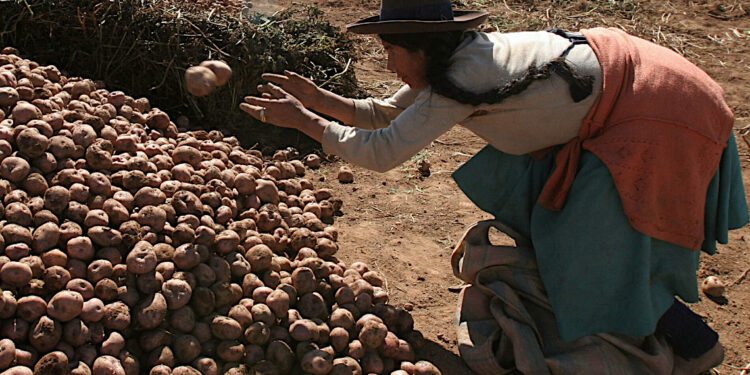The potato is one of the most influential crops in human history, with roots deeply planted in the Peruvian Andes, where ancient populations began cultivating it thousands of years ago. Over the centuries, the potato evolved from a staple food in Peruvian communities to a global staple, crucial for the development of civilizations such as the Inca. This humble tuber not only revolutionized agriculture but remains a core part of Peru’s cultural identity today.
The Origin of the Potato: A Treasure of the Andes
The history of the potato goes back some 7,000 to 10,000 years in the highlands of the Andes, in what is now parts of Peru and Bolivia. This region, rich in biodiversity, provided the ideal environment for the cultivation of plants.
Early Andean societies noticed that certain wild potato species thrived in the rugged, mountainous soil. Through selection and adaptation, these indigenous farmers managed to reduce the toxicity of wild potatoes and develop tastier, more nutritious varieties.
The potato became indispensable to Andean communities, who learned to adapt the plant to various climates. Today, Peru boasts more than 4,000 native potato varieties, a testament to the resourceful and innovative farming methods of pre-Columbian civilizations.
The Role of the Incas in Spreading the Potato
The Incas, one of the most powerful civilizations in ancient Peru, were pivotal in establishing the potato as a cornerstone of their economy and society. Within the vast Inca Empire, spanning from the Andes to the coast and rainforest, the potato became essential thanks to its adaptability to different elevations and climates.
The Incas developed advanced agricultural techniques such as terrace farming and irrigation systems, allowing potatoes to grow at high altitudes and in extreme conditions. They also devised ways to preserve potatoes, like “chuño,” a naturally freeze-dried potato left outside overnight, which could be stored for years. This was essential for feeding their population and army during times of famine or poor harvests.
In Inca culture, the potato was not just food but also a spiritual element. It was seen as a gift from nature and was often offered to Pachamama, Mother Earth, in rituals to bless the fertility of the land.

The Global Journey of the Potato
The potato remained in the Andes for thousands of years until the Spanish conquerors brought it to Europe in the 16th century. Though initially met with suspicion, the potato soon proved to be indispensable in times of famine, especially in places like Ireland, where it became a dietary staple.
From there, the potato spread around the world, its resilience and nutritional value turning it into a lifesaver for millions. Thanks to its ability to thrive in various climates and its high nutritional value, it became one of the world’s primary food sources.
The Potato in Peruvian Identity
Despite its global success, the potato remains a symbol of national pride in Peru. The incredible variety of potatoes — over 4,000 types — plays a vital role in Peruvian cuisine, with traditional dishes like papa a la huancaína and causa limeña deeply embedded in Peruvian culture.
In many Andean communities, traditional farming practices are still used to grow potatoes. Farmers, many of whom are direct descendants of the Incas, preserve age-old methods to ensure the biodiversity and cultural heritage of their crops.
For Peruvians, the potato is not just a food; it is a symbol of resistance, innovation and connection to the land.
A Living Legacy
Today, the potato is still an essential crop for Peru’s agricultural economy, with efforts underway to preserve native varieties and promote their consumption nationally and internationally. Peruvian chefs, such as Gastón Acurio, have helped bring international attention to the potato by reinventing traditional dishes with a modern twist.
The history of the potato reflects the ingenuity of ancient Peruvian agriculture. For Peruvians, the potato is more than just food; it symbolizes resilience, innovation, and a deep connection to the land. From the Andean highlands to tables worldwide, the potato remains a living legacy of Peru’s rich cultural and agricultural history.




